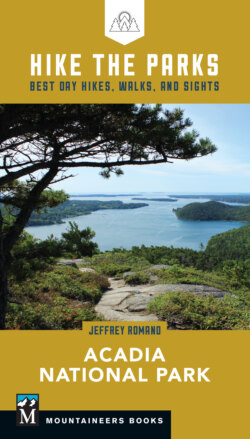Читать книгу Hike the Parks: Acadia National Park - Jeff Romano - Страница 13
На сайте Литреса книга снята с продажи.
ANCIENT LAND CARVED BY ICE
ОглавлениеAcadia was born when mud, sand, and volcanic ash accumulated in an ocean that no longer exists. Hardened into solid bedrock through the years, the landscape eventually succumbed to the pressures of continental ice sheets.
Land of Granite. The ocean sediments that initiated Acadia’s formation were buried deep under the earth’s surface through the passing years. With heat and pressure, the mineral layers metamorphosed into Ellsworth Schist—a rock composed of white and gray quartz, feldspar, and green chlorite. Erosion and the movement of continental plates forced the schist to the surface. Then, roughly 450 million years ago, this oldest rock in Acadia combined with finegrained sand and silt to create the Bar Harbor Formation. Volcanic eruptions soon contributed lava flows and ash. As the landscape cooled, Mount Desert Island’s granite rocks formed. Cadillac Mountain Granite, estimated to be 420 million years old, surrounds the park’s highest summit.
Years of Erosion. Not much evidence exists to capture the next few hundred million years. Softer rocks eroded, valleys formed, and harder surfaces remained. This process accelerated over the last 2 to 3 million years as successive ice ages scoured the landscape. During the most recent one, the Wisconsin glaciation, ice accumulated to a depth of 1 mile km). This glaciation peaked around eighteen thousand years ago and lasted another six to seven thousand years.
Signs of Glaciation. Today’s Acadia shows many signs of the massive ice sheet that most recently polished, scratched, and carved the mountains. Classic U-shaped valleys lie between impressive granite ridges. Scattered across the land are deposits of sand, gravel, and rock, including glacial erratics—large boulders carried as far as 20 miles (32.2 km) by the ice. Bubble Rock and many other lesser-known examples can be found throughout the park.
Bubble Rock with Eagle Lake in the distance (Hike 13)
Changing Sea Levels. The ice sheet’s size and weight also forced the land down, allowing the ocean to expand its reach. Evidence of beaches and marine caves can be found in the park, at elevations nearly 300 feet (91 m) above today’s sea level. As the ice receded enough for the land to rebound and rise, glacial deposits formed dams that cut off salt water to low-lying areas. Today, these basins are home to many of the region’s freshwater lakes and ponds.
